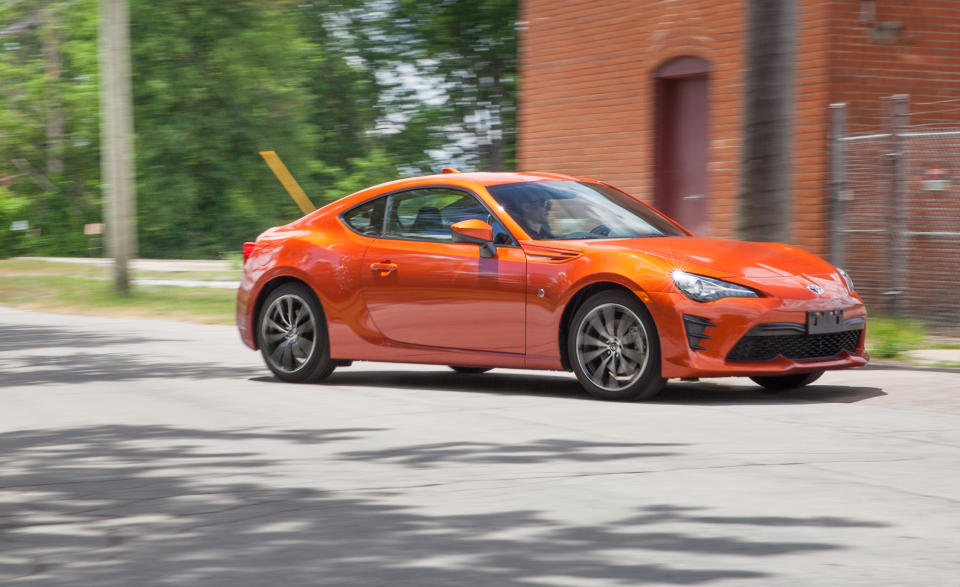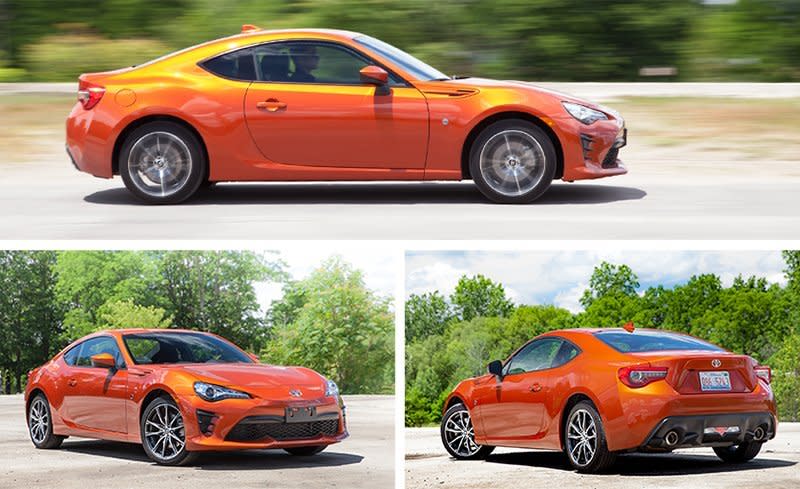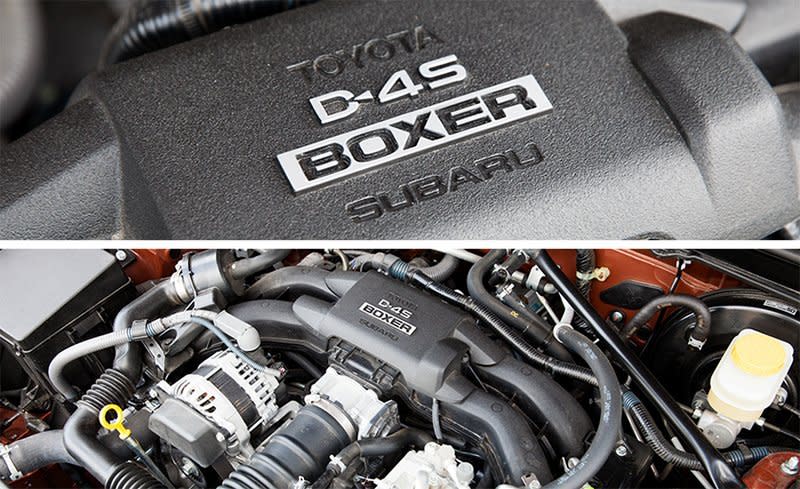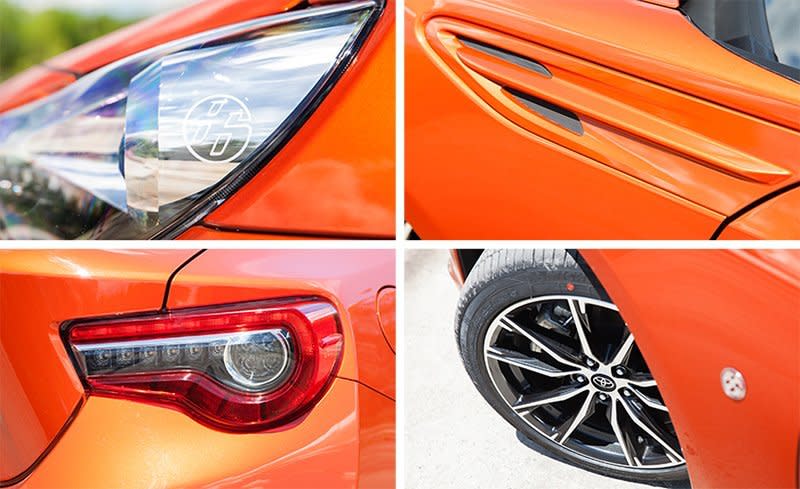2017 Toyota 86 Automatic

Changing the name did not change the character of the Toyota 86, the sports coupe first introduced in the United States as the Scion FR-S and a twin to the Subaru BRZ. So we’ll go ahead and sound like a broken record, having already said over and over again: “Great balance and fantastic steering, but it needs more power. Turbocharge it.” The relative lack of power has been the main point of discussion since the car was announced. Though some argue it’s fine as is, the Subaru-assembled boxer four is drumming up a lot of business for aftermarket tuners that promise they can squeeze more out of it. For their part, Toyota and Subaru say that adding power would add cost, complexity, and mass. They sound a lot like Mazda talking about its similarly modest Miata, actually.
A light, supremely balanced rear-wheel-drive sports coupe such as the 86 entices enthusiasts with its manual transmission, but there’s another choice, which is the subject of this test: a six-speed automatic transmission, which costs an extra $720 and brings paddle shifters to the back of the steering wheel. According to Toyota, this was the choice of 60 percent of its 86 buyers through July of this year. Is their experience just as fun?

Mask on, Mask off
After Toyota nixed the Scion brand, the FR-S—already known as the Toyota GT86 in other markets around the world—reemerged in the U.S. as the Toyota 86 with a few small chassis upgrades, an altered interior, and a lightly refreshed exterior for 2017. Though the car’s shape looks more akin to the 2000GT’s, the numerical name is a call back to the famed rear-wheel-drive AE86 Corolla of the 1980s.
For models with a manual transmission, the 2.0-liter flat-four was upgraded to make 205 horsepower at 7000 rpm and 156 lb-ft of torque at 6400 rpm, improvements of five units each. As with the Subaru BRZ, though, Toyota didn’t upgrade the engine on cars with the automatic. Those are still rated at 200 horsepower, sent through a 4.10:1 final-drive ratio versus manual cars’ new differential with 4.30:1 gears. Revisions to the dampers and spring rates apply to versions with both transmissions.
Toyota said the decision not to include the engine upgrades on cars with the automatic was intended to create differentiation between the two. The manual is positioned as a hard-core model with potential for track duty, while the automatic has more appeal for people who might be buying for style and daily drivability in traffic. If you’re thinking five horses don’t make much of a difference to marketing or performance, we’re in agreement.

Though we’re still team #savethemanuals, automatic transmissions don’t have quite the negative connotation they did 10 years ago. Many high-end sportscar and supercar makers don’t even offer manuals, because computer-controlled twin-clutch transmissions now can launch harder and shift faster and more accurately than humans can. Such gearboxes actually maximize the cars’ performance while at the same time being more efficient. But this is not a high-end car, nor is it superfast, and rowing the gears is part of the total experience and appeal.
That’s especially true because the 86’s transmission is not the latest twin-clutch design but a conventional torque-converter automatic. This six-speed transmission’s shifts feel quick and crisp enough, and Toyota’s Dynamic Rev Management blips for downshifts, but this is one case where a driver using a clutch pedal readily outperforms the automatic. This engine’s lofty 6400-rpm torque peak means there is little thrust available at most speeds without kicking down a gear or three. The steering-wheel-mounted paddle shifters at least make this easier with solid action and a satisfying click; if you choose Sport mode, the car holds the selected gear until told otherwise (it’ll bump the rev limiter rather than shift for itself), which infuses at least a small amount of manual fun.
But that just reminds you of the engine’s struggle—it doesn’t sound great, it has a definite midrange sag in its torque delivery, and it’s not particularly eager to rev. That said, the flat-four does contribute to the dynamic package by lowering the center of gravity, aiding handling.

By our measures, the automatic version weighs 57 pounds more than the manual 86 we tested, and, at 7.7 seconds, it needed 1.5 seconds more to get from zero to 60 mph. Braking from 70 mph occurs in 165 feet, within four feet of the manual’s performance, while skidpad grip is 0.90 g, an insignificant 0.01 g better than we measured with the manual.
Toyota said its recalibrated suspension tuning for 2017 is intended to produce sharper turn-in response, and our drivers noted that it had improved over the Scion in this respect, but it’s pretty much the same car as ever—balanced and entertaining but not fast. Its steering doesn’t feel as lively and responsive as a Miata’s, resembling instead the more relaxed approach of the Fiat 124, but it’s still well within the spectrum to make driving fun.
Inferior Interior
The Toyobaru duo has always had a functional interior. Pleasant? Not exactly. The new Toyota 86 boasts a refreshed interior, though, that is lined with what Toyota calls Granlux. It’s a faux-suede material used to surround the infotainment screen, cover the passenger-side dashboard, and wrap the upper portion of the doors, lending the cabin a warmer vibe. Contrast stitching on the door panels, dashboard, fabric seats, center console, and shift boot add more style, and the grippy, leather-wrapped steering wheel is an ideal size for sporty driving.

However, using the same shift knob as the manual shifter is corny, and a grained plastic used throughout the cabin looks cheap. If cupholders are a priority to you, know that they weren’t to Toyota; they’re located just about where you want to rest your right elbow, making for an awkward reach and arm-to-cup collisions (albeit fewer than in the manual model). We’d say they’re at least convenient for rear-seat passengers, but it’s doubtful that anybody would willingly sit in that tight space.
A final frustration is the infotainment system, which, like the rest of the interior, has improved but not enough to be good. It looks, feels, and performs like an aftermarket unit. The Bluetooth had trouble staying connected, there’s no Apple CarPlay or Android Auto compatibility, there’s no native navigation function, and the eight-speaker audio system sounded tinny. Owners would be well advised to find a mount for their smartphones and maybe consider aftermarket upgrades to the audio system. Unlike the BRZ, which offers a choice between Premium and Limited models, the 86 has only one trim level and no option packages.
There are roughly twice as many vehicles plying American roads today as when Toyota was building the original AE86, and the appeal of an automatic in denser traffic zones is indisputable. Yet the manual fosters a better car-driver connection, and the 86’s clutch and gearbox aren’t enough of a chore to work that they create a huge issue in traffic. In today’s market, getting 40 percent of buyers to choose the stick in any model is a huge thing—take rates on manuals are more typically 3 to 5 percent—and this test illuminated why it is so popular.
Specifications >
VEHICLE TYPE: front-engine, rear-wheel-drive, 4-passenger, 2-door coupe
PRICE AS TESTED: $27,870 (base price: $27,870)
ENGINE TYPE: DOHC 16-valve flat-4, aluminum block and heads, port and direct fuel injection
Displacement: 122 cu in, 1998 cc
Power: 200 hp @ 7000 rpm
Torque: 151 lb-ft @ 6400 rpm
TRANSMISSION: 6-speed automatic with manual shifting mode
DIMENSIONS:
Wheelbase: 101.2 in
Length: 166.7 in
Width: 69.9 in Height: 50.6 in
Passenger volume: 80 cu ft
Trunk volume: 7 cu ft
Curb weight: 2811 lb
C/D TEST RESULTS:
Zero to 60 mph: 7.7 sec
Zero to 100 mph: 20.3 sec
Zero to 120 mph: 33.4 sec
Rolling start, 5–60 mph: 8.0 sec
Top gear, 30–50 mph: 4.3 sec
Top gear, 50–70 mph: 5.1 sec
Standing ¼-mile: 16.0 sec @ 91 mph
Top speed (redline limited): 126 mph
Braking, 70–0 mph: 165 ft
Roadholding, 300-ft-dia skidpad: 0.90 g
FUEL ECONOMY:
EPA combined/city/highway: 27/24/32 mpg
C/D observed: 27 mpg
C/D observed 75-mph highway driving: 37 mpg
C/D observed highway range: 480 mi

 Yahoo Autos
Yahoo Autos 